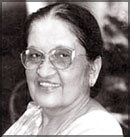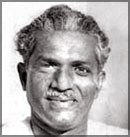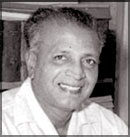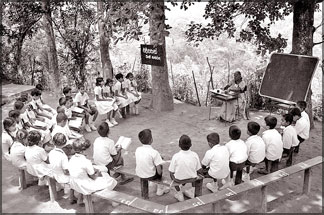Schools take over, attempted 1962 coup
W T A Leslie Fernando
After the July 1960 General Election, Sirimavo Bandaranaike, the
leader of the SLFP was appointed to the Senate and was made the Prime
Minister. Thereby she became the first woman Prime Minister in the world
and brought glory to Sri Lanka. Although she was a novice to politics,
she picked up and soon became a versatile leader. Besides the image she
created as a real Sinhala Kula Kanthava (noble lady) clad in Osariya
made her a popular personality all over.
As the Premier of the SLFP Government for four years from 1960 to
1964 she faced all the controversial issues like the schools takeover,
nationalisation of banks, insurance companies and Petroleum products
with firm courage.
Sirima-Shastri Pact
Her period also saw the development of local industry where so many
products from the pin to refrigerators were manufactured in our country.
She was also bold enough to overcome the attempted coup by the Armed
Forces in 1962.

Dr C W W Kannangara |

Sirimavo Bandaranaike |

Philip Gunawardena |

Dr N M Perera |
Sirimavo Bandaranaike won International fame as she was able to
negotiate a settlement in the border dispute between India and China.
She was also able to solve the problem of the Tamils of Indian origin by
the Sirima-Shastri Pact. She also settled the Kachchativu issue in Sri
Lanka’s favour after discussions with India.
The first controversial issue tackled by Sirimavo Bandaranaike was
the schools takeover. Before Dr W Dahanayake became the Education
Minister in the 1956-59 MEP Government, he had expressed that to make
free education effective, all the assisted schools should be vested in
the State. Once he was appointed the Education Minister he became close
to the Catholic Church and gave an undertaking that assisted schools
would not be taken over by the Government.
Free education scheme
Besides Dr W Dahanayake was the leader of the gang of Ministers who
opposed the progressive policies of Philip Gunawardena’s group in the
1956-59 Cabinet. At the 1960 March election, it was the policy of the
LPP led by Dr W Dahanayake that the assisted schools would not be vested
in the State and the party got support from some Catholic circles.
Under the British colonial regime, Catholics and Christians enjoyed a
privileged position in the field of education. By 1939, both Catholics
and other Christians who comprised only 6.25 percent of the population
obtained 73.2 percent Government grant for denominational schools
whereas Buddhists, Hindus and Muslims who constituted 93.7 percent of
the population received the balance 26.3 percent of the grant. (Prof J E
Jayasuriya; Education in Ceylon - page 3) Besides higher education which
was in English was fee-levying and was limited.
In 1945, Dr C W W Kannangara implemented the Free Education Scheme.
His next move was to takeover all the assisted schools. But it was
shelved when he lost the Matugama seat at the 1947 General Election. In
1952, Dr C W W Kannangara was returned to Parliament from Agalawatta
seat and it is said he was not made the Education Minister due to
pressure from the Church.
Catholic Church
At the 1960 July election the SLFP vociferously declared that the
assisted schools would be vested in the State. Accordingly the Schools
Takeover Act was passed in Parliament with a majority of 60 members.
Only the UNP and the Federal Party voted against it. Nevertheless the
Catholic Church was getting ready from 1956 to resist the Schools
Takeover. In 1959, at a meeting held in Negombo, T B Cooray the
Archbishop of Colombo said, “Our schools should not be touched. We would
fight to the end even by shedding blood” (Dinamina June 30, 1959).
|

Free education, the right of every child. File photo |
When the schools were taken over, many Catholics at the instigation
of the Catholic Church protested against it. Some Catholics forcibly
occupied schools and many schools in Catholic areas had to be closed.
This took a serious turn in the Negombo known as the little Rome and
Catholic areas in the vicinity.
However, it was the Leftists Catholics in Negombo itself who
shouldered to mobilise Catholics in favour of the schools takeover.
Although at this time the MEP was against the Government it vehemently
supported the schools takeover. Accordingly the LSSP, MEP and the CP in
Negombo area formed an organization ‘National Education Protection Front
in Catholic areas.’
This organization mobilised the Catholics in the coastal belt from
Wattala to Puttalam in favour of the Schools Takeover. It held meetings
in Catholic areas highlighting the benefits of the Schools Takeover to
the poor Catholics. The Leftist leaders in Negombo Dr Hector Fernando,
Santigo Fernando, Cecil de Silva with others like Ven Meegomuwe
Jinawansa Nayake Thera and Senator A D Jayasekera addressed these
meetings. The organization also got the blessings of Lakshman Jayakody,
MP for Divulapitiya.
The Catholic Church that got excited over these developments also
formed an organization called ‘The Catholic Education Protection Front’.
However, the SLFP Catholics in the area joined the Leftists in favour of
the Schools Takeover. Sarath Meepura a bold and courageous teacher and
LSSP Youth League leader teaching in the Dalupotha Catholic school
released the journal called Vipla to create a public option in favour of
the Schools Takeover. Over 5,000 copies of this journal was sold in
Negombo itself.
The ‘National Education Front in Catholic Areas’ handled the
situation carefully and avoided any confrontation. The leader of the MEP
in Negombo and veteran writer Santiago Fernando wrote a series of
articles in the pro-SLFP journal Sinhale illustrating the benefits of
the Schools Takeover to masses.
Schools Takeover
Some Catholic teachers who were victimised by the Catholic Church
openly supported the Schools Takeover. The Catholic parents who realised
that the education of their children by the closure of schools would be
adversely affected began to support the move. Gradually there developed
a public opinion among the Catholics themselves in favour of the Schools
Takeover.
In this background Cardinal Graciano of India who came to Sri Lanka
as special envoy to study the Schools Takeover issue, advised the
Catholic Church in Sri Lanka to give up the struggle and the Church
retreated. In the process it managed to get permission to continue some
elite schools like St Joseph’s and St Peter’s colleges as non-fee
levying private schools. In the Schools Takeover issue Badiuddin Mahamud
as the Education Minister at the time tactfully dealt with the situation
without leaving any room for bloodshed.
Although Prime Minister Sirimavo Bandaranaike was educated at St
Bridget’s Convent, a leading Catholic Convent she stood firm and never
yielded to any pressure from the Catholic Church. She always spoke with
pride over the Schools Takeover until her death in 2000.
Leftist parties
The Schools Takeover was indeed a blessing for even the poor Catholic
children and the country as a whole. Before the Schools Take Over it was
very rarely that the child of a poor fisherman or a carpenter could
enter the University from a prestigious Catholic school. Now the higher
education has reached even the poorest of the poor Catholics. This is
evident from the Puttalam District that has the largest Catholic
percentage except for the Mannar District that has a very thin
population. Every year many poor Catholics in the Puttalam District pass
out as professionals.
Although at the Schools Takeover the Catholic Church was allowed to
have non-fee-levying schools. Illegal sums are collected from parents at
the admission to the schools in the name of ‘Donations’. It is
unbecoming of the representatives of God to charge such illegal sums in
the name of donations.
By 1961, the LSSP and the CP that supported the Government began to
move away from it. The two parties refrained from voting for the Throne
Speech. At the end of 1961 there was a series of strike in banks, the
port and in transport services. The Government used the Army and the
Navy to operate the services.
The MEP and the CP was formed against the suppression of the strikes
by the Government. This front organized a strike for January 5, 1962.
The strike was a success and it disrupted the work in industry, in
offices, transport, post and communications.
Towards the end of January an attempted coup by the high-ranking
officers of the Army and the Police was discovered. The Leftist parties
condemned it and the MEP and the CP called off the strike as a show of
goodwill to the Government even without informing the LSSP. (Prof Y
Ranjith Amarasinghe; Revolutionary Idealism and Parliamentary Politics
(2000) - page 147).
Security Forces
At the Appropriation Bill Committee Stage in 1960-61 Philip
Gunawardena cautioned the Government of high-ranking officers of the
forces had confessed in the presence of a Catholic priest. True to
Philip’s forecast the Coup was timed for 1962 and it failed due to the
presence of mind of one patriotic officer (Dr Ananda Meegama; Philip
Guanwardena and the 1956 Revolution in Sri Lanka (2008) - page 198).
The 1962 coup dated to overthrow the Government was fixed for January
27, 1962 and it was uncovered by the Government on the day before it was
carried out. Prime Minister Sirimavo Bandaranaike and Minister Felix
Dias Bandaranaike tackled the situation with boldness and courage. About
two-dozen officers of the Security Forces and some civilians were taken
into custody. The coup plan entailed the arrest of several members of
the Government and leading Leftists. (Prof Y Ranjith Amarasinghe
Revolutionary Idealism and Parliamentary Politics (2000) - page 147)
The social background of the coup suspects were mostly Catholics from
the higher strata in society close to the Catholic Church. The 1962
abortive coup has been interpreted as a move orchestrated by the
Catholic circles because of the Schools Take Over.
The MEP hitherto least sympathetic to the Government offered it and
people every assistance possible to rid the country finally and totally
from all the conspiratorial elements. The CP also promised full support
to the Government to deal with the reactionary forces. The LSSP position
the coup was ambiguous. (Prof Y Ranjith Amarasinghe; Revolutionary
Idealism and Parliamentary Politics (2000) - page 147)
The LSSP condemned the coup as a rightist plot emphasizing that the
social background of the coup suspects were mostly Catholics from the
established families. But interpreted that the Government had planned to
arrest the working-class leaders but the forces detailed for the purpose
had gone one step further and planned the detention of some members of
the Government. Dr N M Perera implied this position in the House of
Representatives Doric de Souza in the Senate and it was also mentioned
in the editorial notes of the Young Socialist. (Prof Y Ranjith
Amarasinghe; Revolutionary Idealism and Parliamentary Politics (2000) -
page 147)
When the Government introduced a bill to set up a special Court to
try the coup suspects the MEP and the CP voted with the Government for
it but the LSSP voted against it with the UNP and the Federal Party.
(Dr Y Ranjith Amarasinghe; Revolutionary Idealism and Parliamentary
Politics (2000) - page 148)
Why did the LSSP made such serious allegations against the SLFP
Government? Because of some misgivings of the coup the LSSP was isolated
from both the MEP and the CP for sometime.
(The writer is a former President of the Newman Society Alumni
Association) |



